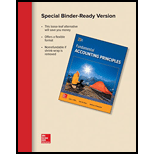
Concept Introduction:
Cost of goods sold: It refers to all the costs that a business incurred to produce a product. It is computed by using the following formula:
Acid test ratio: It is also known as
To Determine:
1. The net cost of goods purchased for the year ended September 26, 2015.
2. Current and acid test ratio related to year ended September 26, 2015 and September 27, 2014 and also, compare the same with the industry average of 1.5 for the current ratio and 125 for the acid test ratio.
Want to see the full answer?
Check out a sample textbook solution
Chapter 5 Solutions
Loose Leaf for Fundamental Accounting Principles
- Do fast answer of this general accounting questionarrow_forwardSolve this Accounting problemarrow_forwardSheinberg Industries reported 2023 sales ($ in millions) of $6,842 and a cost of goods sold of $5,120. The company uses the LIFO method for inventory valuation. It discloses that if the FIFO inventory valuation method had been used, inventories would have been $89.6 million and $73.2 million higher in 2023 and 2022, respectively. If Sheinberg used the FIFO method exclusively, it would have reported 2023 gross profit closest to? a. $1,110.5 million b. $1,319.1 million c. $1,738.4 millionarrow_forward
- What would be the balance of the ending work in process inventory account?arrow_forwardI am searching for the correct answer to this financial accounting problem with proper accounting rules.arrow_forwardI am trying to find the accurate solution to this general accounting problem with appropriate explanations.arrow_forward
- I need guidance with this general accounting problem using the right accounting principles.arrow_forwardThe Dortmund Company uses the weighted-average method in its process costing system. The company's ending work in process inventory consists of 18,500 units. The ending work in process inventory is 100% complete with respect to materials and 60% complete with respect to labor and overhead. If the costs per equivalent unit for the period are $5.20 for materials and $4.10 for labor and overhead, what would be the balance of the ending work in process inventory account? (Do not round cost per equivalent unit) A. $142,265 B. $96,200 C. $141,710 D. $106,745arrow_forwardGiven the following information how much raw material was transferred to work in progress on March 31? Inventory on March 1 is $420,000, raw materials purchased in March are $780,000, and raw materials inventory on March 31 is $310,000. A: $890,000 B: $940,000 C: $750,000 D: $1,040,000arrow_forward

 AccountingAccountingISBN:9781337272094Author:WARREN, Carl S., Reeve, James M., Duchac, Jonathan E.Publisher:Cengage Learning,
AccountingAccountingISBN:9781337272094Author:WARREN, Carl S., Reeve, James M., Duchac, Jonathan E.Publisher:Cengage Learning, Accounting Information SystemsAccountingISBN:9781337619202Author:Hall, James A.Publisher:Cengage Learning,
Accounting Information SystemsAccountingISBN:9781337619202Author:Hall, James A.Publisher:Cengage Learning, Horngren's Cost Accounting: A Managerial Emphasis...AccountingISBN:9780134475585Author:Srikant M. Datar, Madhav V. RajanPublisher:PEARSON
Horngren's Cost Accounting: A Managerial Emphasis...AccountingISBN:9780134475585Author:Srikant M. Datar, Madhav V. RajanPublisher:PEARSON Intermediate AccountingAccountingISBN:9781259722660Author:J. David Spiceland, Mark W. Nelson, Wayne M ThomasPublisher:McGraw-Hill Education
Intermediate AccountingAccountingISBN:9781259722660Author:J. David Spiceland, Mark W. Nelson, Wayne M ThomasPublisher:McGraw-Hill Education Financial and Managerial AccountingAccountingISBN:9781259726705Author:John J Wild, Ken W. Shaw, Barbara Chiappetta Fundamental Accounting PrinciplesPublisher:McGraw-Hill Education
Financial and Managerial AccountingAccountingISBN:9781259726705Author:John J Wild, Ken W. Shaw, Barbara Chiappetta Fundamental Accounting PrinciplesPublisher:McGraw-Hill Education





